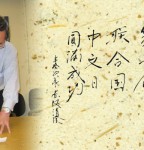P3: Mission of Art
“My soul is always longing. That’s why I need art.”
Generally speaking, people practice art for art’s sake, self interest or entertainment, moral and philosophy, or personal spiritual growth. Except for personal entertainment, the mission of art refers to the inner calling to creatively serve our physically and spiritually depleted world. The artist can be a spiritual emissary working in any medium in any part of culture or any forms of art. The artist’s mission is applied vision in that it connotes personal, passionate, and eternal commitment to art.
The will to make art is the will to affirm life, to express our unique beauty and truth by devotional labor. This is a simple message anyone can appreciate: the artists take delight in and care for their work, and we thereby are inspired to find delight in our own work. If the mission of art involves opening the eye of the heart so spirit can be seen and felt, this goal can only be reached when both artist and viewer observe art as a holy covenant.
Art that feeds the soul is a visionary covenant among spirit, artist, and audience. The artist is responsible for outwardly manifesting and inwardly perceived transcendental source. By contemplative absorption in the artist’s vision, viewers place themselves in the mind of the artist at the moment of inspiration. Viewers receive the same transmission and enter the covenant relationship. A viewer of a Chinese calligraphy work does not worship a two-dimensional image but the spiritual beauty the image mirrors. In Chinese painting, one could find animals, birds, flowers, and humans that were not only accurately depicted in shape and manner. The object’s internal substance, emotion, ideas, and aspiration were also captured by the artists.
書法與德性可有關聯?
儒家所言「仁、義、禮、智、信」五德,於書法亦然,二者互為因果。
「仁」者善也,心善者度量大,並善為他人著想,處處圓滿而心理平衡;於字亦然,必呈現和諧而統一,於結體上則善相救相助。
「義」者,行所當行,止所當止,則其人所書寫之字,氣勢從容不迫,行氣貫串,氣脈流暢。
「禮」者規矩也,其人字必井然有序,中規中矩不嬌媚;結構與行氣,相敬復若相讓,不致凌亂。
「智」者善調理安排,故所書之字組合自然得宜,所謂「善行無轍跡」,「善計不用籌策」, 而「常善救物,故無棄物」猶常善救筆,故無失筆。
「信」者不我欺,自信亦信人,故所寫之字線條肯定,字穩而有神,不做作,不求媚取寵, 卓然而獨立。
古云「字若其人」、「字即心畫」,即由字象可知心象,故復稱之為書法「五德」。
The five virtues of “benevolence, righteousness, politeness, wisdom, and honesty” mentioned by the Confusianism also are imbedded in Chinese calligraphy, and they complement and complete each other.
Michelangelo Buonarroti (1475-1564) was trying symbolically express through his art a spiritual ideal clothed in material form. He once said, “It’s not sufficient merely to be a great master in painting and very wise, but I think it’s necessary for the painter to be very moral in his mode of life, or even if such were possible, a saint, so that the Holy Spirit may inspire his intellect.”
Anton Rubinstein wrote in his autobiography, “… insight to realize the divine, spiritual, and emotional message which music has to convey to those who understand –and care.“ This is the insight he sought to awaken in his own students. He was the greatest pianist after Franz Liszt, and Hans von Bulow called him “the Michelangelo on the piano.”
A good Chinese calligrapher enriches the soul of humanity. He delights viewers with nuances of shades of strokes and structure. He further reveals spiritual pureness and richness until then unknown, and gives people new reasons for loving life and new inner lights to guide them.
| < Prev | Next > |
|---|
- 2011-05-06 - KUSHO: Calligraphy in The Sky, Shinichi Maruyama, Janpan Modern Art
- 2011-05-04 - Wang Xizhi, The Sage of Chinese Calligraphy
- 2011-04-23 - Ouyang Xun, one of the Four Great Calligraphers of Early Tang Dynasty
- 2011-04-07 - Chu Suiliang 褚遂良, one of the Four Great Calligraphers of Early Tang Dynasty
- 2011-01-07 - 文徵明行书《明妃曲》
- 2010-08-10 - Laozi (Lao-tzu, fl. 6th C. BCE)
- 2010-08-08 - The Dragon's Embrace - China's Soft Power Is a Threat to the West
- 2010-04-19 - The Core of Chinese Culture
- 2010-03-12 - Bringing it All Back Home: Chu Teh-Chun at NAMOC













